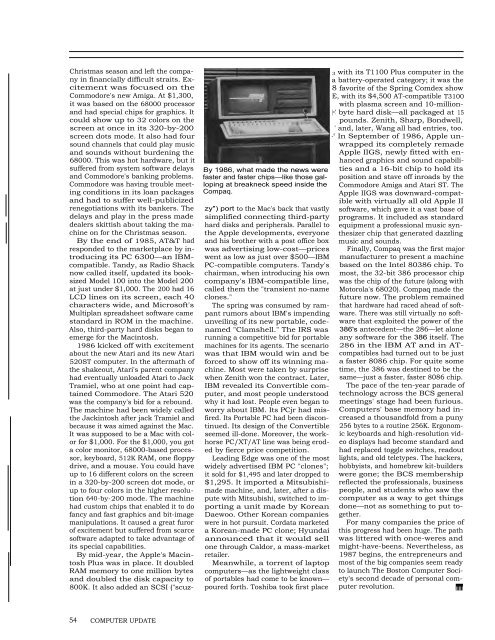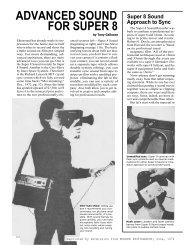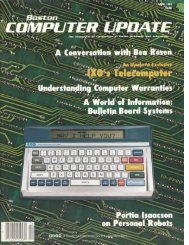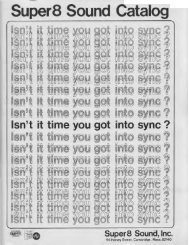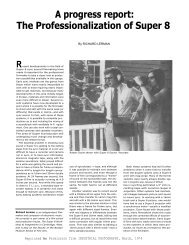established - Desktop Video Group
established - Desktop Video Group
established - Desktop Video Group
You also want an ePaper? Increase the reach of your titles
YUMPU automatically turns print PDFs into web optimized ePapers that Google loves.
Christmas season and left the company<br />
in financially difficult straits. Excitement<br />
was focused on the<br />
Commodore's new Amiga. At $1,300,<br />
it was based on the 68000 processor<br />
and had special chips for graphics. It<br />
could show up to 32 colors on the<br />
screen at once in its 320-by-200<br />
screen dots mode. It also had four<br />
sound channels that could play music<br />
and sounds without burdening the<br />
68000. This was hot hardware, but it<br />
suffered from system software delays<br />
and Commodore's banking problems.<br />
Commodore was having trouble meeting<br />
conditions in its loan packages<br />
and had to suffer well-publicized<br />
renegotiations with its bankers. The<br />
delays and play in the press made<br />
dealers skittish about taking the machine<br />
on for the Christmas season.<br />
By the end of 1985, AT&T had<br />
responded to the marketplace by introducing<br />
its PC 6300—an IBMcompatible.<br />
Tandy, as Radio Shack<br />
now called itself, updated its booksized<br />
Model 100 into the Model 200<br />
at just under $1,000. The 200 had 16<br />
LCD lines on its screen, each 40<br />
characters wide, and Microsoft's<br />
Multiplan spreadsheet software came<br />
standard in ROM in the machine.<br />
Also, third-party hard disks began to<br />
emerge for the Macintosh.<br />
1986 kicked off with excitement<br />
about the new Atari and its new Atari<br />
520ST computer. In the aftermath of<br />
the shakeout, Atari's parent company<br />
had eventually unloaded Atari to Jack<br />
Tramiel, who at one point had captained<br />
Commodore. The Atari 520<br />
was the company's bid for a rebound.<br />
The machine had been widely called<br />
the Jackintosh after jack Tramiel and<br />
because it was aimed against the Mac.<br />
It was supposed to be a Mac with color<br />
for $1,000. For the $1,000, you got<br />
a color monitor, 68000-based processor,<br />
keyboard, 512K RAM, one floppy<br />
drive, and a mouse. You could have<br />
up to 16 different colors on the screen<br />
in a 320-by-200 screen dot mode, or<br />
up to four colors in the higher resolution<br />
640 -by-200 mode. The machine<br />
had custom chips that enabled it to do<br />
fancy and fast graphics and bit-image<br />
manipulations. It caused a great furor<br />
of excitement but suffered from scarce<br />
software adapted to take advantage of<br />
its special capabilities.<br />
By mid-year, the Apple's Macintosh<br />
Plus was in place. It doubled<br />
RAM memory to one million bytes<br />
and doubled the disk capacity to<br />
800K. It also added an SCSI ("scuz-<br />
54 COMPUTER UPDATE<br />
By 1986, what made the news were<br />
faster and faster chips—like those galloping<br />
at breakneck speed inside the<br />
Compaq.<br />
zy") port to the Mac's back that vastly<br />
simplified connecting third-party<br />
hard disks and peripherals. Parallel to<br />
the Apple developments, everyone<br />
and his brother with a post office box<br />
was advertising low-cost—prices<br />
went as low as just over $500—IBM<br />
PC-compatible computers. Tandy's<br />
chairman, when introducing his own<br />
company's IBM-compatible line,<br />
called them the "transient no-name<br />
clones."<br />
The spring was consumed by rampant<br />
rumors about IBM's impending<br />
unveiling of its new portable, codenamed<br />
"Clamshell." The IRS was<br />
running a competitive bid for portable<br />
machines for its agents. The scenario<br />
was that IBM would win and be<br />
forced to show off its winning machine.<br />
Most were taken by surprise<br />
when Zenith won the contract. Later,<br />
IBM revealed its Convertible computer,<br />
and most people understood<br />
why it had lost. People even began to<br />
worry about IBM. Its PCjr had misfired.<br />
Its Portable PC had been discontinued.<br />
Its design of the Convertible<br />
seemed ill-done. Moreover, the workhorse<br />
PC/XT/AT line was being eroded<br />
by fierce price competition.<br />
Leading Edge was one of the most<br />
widely advertised IBM PC "clones";<br />
it sold for $1,495 and later dropped to<br />
$1,295. It imported a Mitsubishimade<br />
machine, and, later, after a dispute<br />
with Mitsubishi, switched to importing<br />
a unit made by Korean<br />
Daewoo. Other Korean companies<br />
were in hot pursuit. Cordata marketed<br />
a Korean-made PC clone; Hyundai<br />
announced that it would sell<br />
one through Caldor, a mass-market<br />
retailer.<br />
Meanwhile, a torrent of laptop<br />
computers—as the lightweight class<br />
of portables had come to be known—<br />
poured forth. Toshiba took first place<br />
3 with its T1100 Plus computer in the<br />
a battery-operated category; it was the<br />
8 favorite of the Spring Comdex show<br />
E, with its $4,500 AT-compatible T3100<br />
with plasma screen and 10-million-<br />
(=.' byte hard disk—all packaged at 15<br />
pounds. Zenith, Sharp, Bondwell,<br />
' and, later, Wang all had entries, too.<br />
-° In September of 1986, Apple unwrapped<br />
its completely remade<br />
Apple IIGS, newly fitted with enhanced<br />
graphics and sound capabilities<br />
and a 16-bit chip to hold its<br />
position and stave off inroads by the<br />
Commodore Amiga and Atari ST. The<br />
Apple IIGS was downward-compatible<br />
with virtually all old Apple II<br />
software, which gave it a vast base of<br />
programs. It included as standard<br />
equipment a professional music synthesizer<br />
chip that generated dazzling<br />
music and sounds.<br />
Finally, Compaq was the first major<br />
manufacturer to present a machine<br />
based on the Intel 80386 chip. To<br />
most, the 32-bit 386 processor chip<br />
was the chip of the future (along with<br />
Motorola's 68020). Compaq made the<br />
future now. The problem remained<br />
that hardware had raced ahead of software.<br />
There was still virtually no software<br />
that exploited the power of the<br />
386's antecedent—the 286—let alone<br />
any software for the 386 itself. The<br />
286 in the IBM AT and in ATcompatibles<br />
had turned out to be just<br />
a faster 8086 chip. For quite some<br />
time, the 386 was destined to be the<br />
same—just a faster, faster 8086 chip.<br />
The pace of the ten-year parade of<br />
technology across the BCS general<br />
meetings' stage had been furious.<br />
Computers' base memory had increased<br />
a thousandfold from a puny<br />
256 bytes to a routine 256K. Ergonomic<br />
keyboards and high-resolution video<br />
displays had become standard and<br />
had replaced toggle switches, readout<br />
lights, and old teletypes. The hackers,<br />
hobbyists, and homebrew kit-builders<br />
were gone; the BCS membership<br />
reflected the professionals, business<br />
people, and students who saw the<br />
computer as a way to get things<br />
done—not as something to put together.<br />
For many companies the price of<br />
this progress had been huge. The path<br />
was littered with once-weres and<br />
might-have-beens. Nevertheless, as<br />
1987 begins, the entrepreneurs and<br />
most of the big companies seem ready<br />
to launch The Boston Computer Society's<br />
second decade of personal computer<br />
revolution. iiiii


